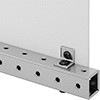Filter by
Bracket Type
Mount Type
Rail Height
Corner Bracket Style
Bolt-Together Framing Component
T-Slotted Framing Component
Strut Channel Framing Component
Finish
Locking-Slotted Framing Component
Mounting Location
Outside Height
Mounting Hole Style
DFARS Specialty Metals
Building and Machinery Hardware
Raw Materials
Fastening and Joining
Measuring and Inspecting


































































































